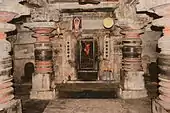Chennakeshava or Chennigaraya Temple | |
|---|---|
Hindu temple | |
 Chennakeshava temple (1263 A.D.) at Turuvekere in Tumkur district | |
| Country | |
| State | Karnataka |
| District | Tumkur District |
| Languages | |
| • Official | Kannada |
| Time zone | UTC+5:30 (IST) |
The Chennakeshava temple (also spelt "Chennakesava" or called "Chennigaraya"), dedicated to the Hindu god Vishnu is located in Turuvekere, a small town in the Tumkur district, Karnataka state, India.[1] Turuvekere, founded as an Agraharam town (a place of learning) in the 13th century is located about 77 miles from the state capital Bangalore. The temple was built around 1263 A.D. during the rule of the Hoysala Empire King Narasimha III.[2] This temple is a protected monument under the Karnataka state division of the Archaeological Survey of India.[3]
Temple plan

According to the art historian Adam Hardy, the temple plan is a distinctive dravida (south Indian) single vimana (one sanctum and superstructure over it, called ekakuta) structure built on a semi-stellate base (semi-star shape). The building material is the standard Soap stone and the hall (mantapa) is a closed one.[2]
The temple has all the basic elements of a standard Hoysala temple and comprises a sanctum which is connected to a closed hall by a square vestibule (sukhanasi). The entrance into the hall from the outside is through a porch (mukhamantapa). Typically, a closed hall in a Hoysala temple has no windows. The porch consists of an awning supported by two decorative half pillars with two parapets on both sides. The shrine has a tower (called shikhara). The vestibule has its own tower (also called sukhanasi) which appears like a low extension of the main tower over the shrine. Art critic Gerard Foekema calls it the "nose" of the main tower. From the outside, the walls of the vestibule are inconspicuous and appear like a short extension of the shrine wall.[4][5][6] The ceiling of the closed hall is supported by four lathe turned pillars. These pillars divide the ceiling into nine highly decorated bays.[5] Between full pilasters, the outer walls of the hall and shrine are decorated with turrets and miniature towers on half-pilasters (aedicula). Below these, forming the base of the temple, are the five horizontal moldings.[7]
Notes
- ↑ "General Information-Tumkur District Tourist Places". Deputy Commissioners Office. National Informatics Center. Retrieved 12 December 2014.
- 1 2 Hardy (1995), p347
- ↑ "Protected Monuments in Karnataka". Archaeological Survey of India, Government of India. Indira Gandhi National Center for the Arts. Retrieved 10 August 2012.
- ↑ Foekema (1996), p21
- 1 2 Foekema (1996), p22
- ↑ Foekema (1996), p24
- ↑ Foekema (1996), p28
References
- Gerard Foekema, A Complete Guide to Hoysala Temples, Abhinav, 1996 ISBN 81-7017-345-0
- Kamath, Suryanath U. (2001) [1980]. A concise history of Karnataka: from pre-historic times to the present. Bangalore: Jupiter books. LCCN 80905179. OCLC 7796041.
- Adam Hardy, Indian Temple Architecture: Form and Transformation : the Karṇāṭa Drāviḍa Tradition, 7th to 13th Centuries, Abhinav, 1995, New Delhi, ISBN 81-7017-312-4.
